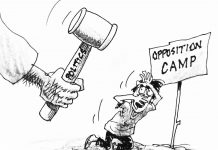It appeared on social media—the rumor that the existing money bills will be nullified and replaced with new designs. If this move is real and not just another baseless fabrication, then such an action would be a masterstroke against plunderers who, for years, have fattened their vaults and mattresses with illicit billions.
I find the thought exhilarating. Imagine the look on the faces of the corrupt if, overnight, their bulging stockpiles of cash suddenly turned into worthless paper, good only for folding boats or wrapping dried fish. For once, the people might not be the losers, but the thieves themselves. What better justice than letting them choke on their hoarded fortunes, unable to parade them into casinos or splurge them on shameless luxuries? This rumor, if true, deserves not just attention but swift execution.
Money, after all, is not just a piece of paper but a symbol of trust. And this trust has been corroded for so long by those who see currency not as a medium of exchange but as a trophy of their thievery. Hoarded money is a grotesque monument to greed. It stagnates, it does not circulate, and in its slumber, it deprives ordinary Filipinos of schools, hospitals, and roads that such funds should have built. By pulling the rug from under the hoarders, we would, at last, prove that ill-gotten wealth cannot simply sit untouched like a sacred cow.
Of course, one must admit, such a move would not be free of complications. Ordinary citizens, particularly in the provinces, still hide small bundles of cash in tin cans under their beds. To them, a sudden demonetization might feel like betrayal if done without warning. This is why the plan must be handled with care, allowing decent citizens ample time to exchange their bills while tightening the noose on those who hoarded massive amounts that cannot possibly be justified. The difference between honest savings and obscene plunder must be drawn with wisdom and precision.
History offers us lessons. India did something similar in 2016, withdrawing high-denomination notes to cripple the underground economy. The results were mixed—ordinary people suffered inconvenience, while some wealthy players found ways to maneuver around it. But what India lacked, perhaps, was the political will to go all the way. In our case, if the rumor is true, then the resolve must be unwavering. Half-measures will only give the corrupt an escape route; full force will corner them.
What I particularly like about this idea is the poetic justice it brings. Corruption has always seemed invincible in this country, its practitioners strutting around unpunished while the masses grind through poverty. To see their hoarded cash turned to confetti would be a symbolic leveling of the scales. It reminds me of biblical times, when idols of gold and silver were cast down and rendered powerless. Here, the idol is paper money, and by nullifying it, we strip it of the false divinity the plunderers have bestowed upon it.
But one must not be naïve. The corrupt are like cockroaches; they will always try to wriggle through the cracks. Some will attempt to launder their hoards through businesses or cronies. Others will cry foul, perhaps even brand the move as unconstitutional. Yet even with these risks, I still see this rumored plan as worth the gamble. After all, the worst outcome is not the inconvenience of standing in line at a bank but the continued reign of plunderers untouched by reform.
Whether this viral rumor is true or not, it has already sparked a conversation worth fostering: how do we strike at the very heart of corruption, not with speeches and hollow hearings, but with action that hits the plunderers where it hurts most? Currency redesign and nullification could be one way. But whatever path is chosen, it must be urgent, bold, and unrelenting. For once, let the billions they stole rot in their hands, while the rest of us breathe in the justice long denied.




